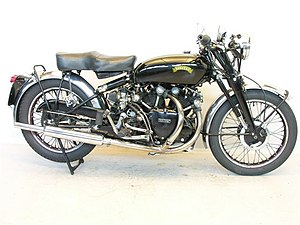Vincent Black Shadow: Difference between revisions
Jnestorius (talk | contribs) |
|||
| Line 42: | Line 42: | ||
==In popular culture== |
==In popular culture== |
||
Journalist [[Hunter S. Thompson]] wrote that, "If you rode the Black Shadow at top speed for any length of time, you would almost certainly die."<ref name=CycleWorld1995>{{Citation |title= Song of the Sausage Creature |last=Thompson |first= Hunter S. |authorlink=Hunter S. Thompson |magazine=[[Cycle World]] |ISSN=0011-4286 |date= March 1995 }}</ref> and praised the model in his 1971 novel, ''[[Fear and Loathing in Las Vegas]]''.<ref>{{cite web |title=Manufacturer's Web Siet |url=http://www.vincent-hrd.co.uk/hst.html |accessdate=24 November 2013}}</ref> |
Journalist [[Hunter S. Thompson]] wrote that, "If you rode the Black Shadow at top speed for any length of time, you would almost certainly die."<ref name=CycleWorld1995>{{Citation |title= Song of the Sausage Creature |last=Thompson |first= Hunter S. |authorlink=Hunter S. Thompson |magazine=[[Cycle World]] |ISSN=0011-4286 |date= March 1995 }}</ref> and praised the model in his 1971 novel, ''[[Fear and Loathing in Las Vegas]]''.<ref>{{cite web |title=Manufacturer's Web Siet |url=http://www.vincent-hrd.co.uk/hst.html |accessdate=24 November 2013}}</ref> |
||
[[Richard Thompson (musician)|Richard Thompson]] wrote "[[1952 Vincent Black Lightning]]", a song on the 1991 album ''[[Rumor and Sigh]]''. |
|||
<gallery> |
<gallery> |
||
Revision as of 15:46, 27 March 2014
 | |
| Manufacturer | Vincent HRD |
|---|---|
| Engine | 998 cc (60.9 cu in) 50 degree OHV V-twin |
| Compression ratio | 7.3:1 |
| Power | 55 bhp (41 kW) @ 5,500 rpm |
The Vincent Black Shadow was a hand-built motorcycle produced by Vincent HRD from 1948. The series "C", which was introduced in 1949, had a 998 cc (60.9 cu in) 50 degree OHV V-twin engine running a 7.3:1 compression ratio.
Model history
The first model from Vincent was the Rapide. However due to demand for a more "sports oriented model", the Black Shadow was introduced. The Black Shadow traced its roots to an early-model Rapide that had been specially tuned by factory tester and racer George Brown, his brother Cliff and legendary Vincent designer Phil Irving.[1] With relatively minor modifications, such as enlarged ports, bigger carburettors and increased compression, the test model, known as "Gunga Din" was soon making 55 bhp (41 kW), creating the specification that would become the Black Shadow.[2] The model became so popular that the production of the Black Shadow exceeded the production numbers of the Rapide. The Black Shadow was a "Stressed Frame" design. The engine, instead of being cradled in a set of frame rails, was suspended from above, becoming a stressed member, or integral part of the structure. The Black Shadow as well as the other post Second World War Vincents featured several new technological innovations, such as a unique and original alternative to the primitive telescopic front forks of the day, a sprung rear sub-frame, the extensive use of aluminium alloy and a unit construction stressed engine. It weighed in at a relatively light 458 lb (208 kg),[3] which was about the weight of a pre-war 500 cc bike.
The inspiration for the Black Shadow was Royal Air Force pilots flying over the factory, and soldiers serving in the war. The designers created a motorcycle that could be operated and maintained by men who had been injured in combat. The clutch could be operated with just two fingers, and maintenance was made far easier than anything previously available.[citation needed]
The reason for its name "Black" Shadow was that the entire bike (including the engine) was coloured black including baked enamel on crank-case and covers. The reason for the black on the crankcases is still disputed to this day. Some claim that the black colour was for looks, others claim that it had something to do with heat transfer and dissipation. Whatever the original reason behind the painting of the engine, it was very different from anything else at a time when everything was polished and chromed. There were a small number (about 16) of White Shadows, machines made to Shadow specification but with the plain aluminium finish of the Rapide. Fewer than 1,700 Vincent Black Shadows were made,[4] all hand-assembled.
In 2007, The Vincent H.R.D. Owners Club commissioned the VOC Spares Company Limited to build a replica Black Shadow from new parts.[citation needed] Amongst other things, the project was to prove that all the parts were in stock and available from the VOC Spares Company Limited. Having received many glowing reports from the motorcycle press in the UK, the machine was eventually auctioned by Bonhams and now resides with a Member of the Vincent H.R.D. Owners Club in New Zealand.
In popular culture
Journalist Hunter S. Thompson wrote that, "If you rode the Black Shadow at top speed for any length of time, you would almost certainly die."[5] and praised the model in his 1971 novel, Fear and Loathing in Las Vegas.[6]
-
Series C Black Shadow.
-
Closeup of the engine
See also
References
- ^ Phillip Tooth (July/August 2009). "Prototype 1948 Vincent Series B Black Shadow". Motorcycle Classics. Retrieved 4 August 2009.
{{cite web}}: Check date values in:|date=(help) - ^ Smith, Robert (May/June 2010). "Historic Vincent: Gunga Din". Motorcycle Classics. Retrieved 27 October 2010.
{{cite web}}: Check date values in:|date=(help) - ^ Duke, Kevin (1 April 2003). "Vincent Genealogy". Motorcycle USA. Retrieved 27 August 2008.
- ^ Template:Wayback
- ^ Thompson, Hunter S. (March 1995), "Song of the Sausage Creature", Cycle World, ISSN 0011-4286
- ^ "Manufacturer's Web Siet". Retrieved 24 November 2013.


